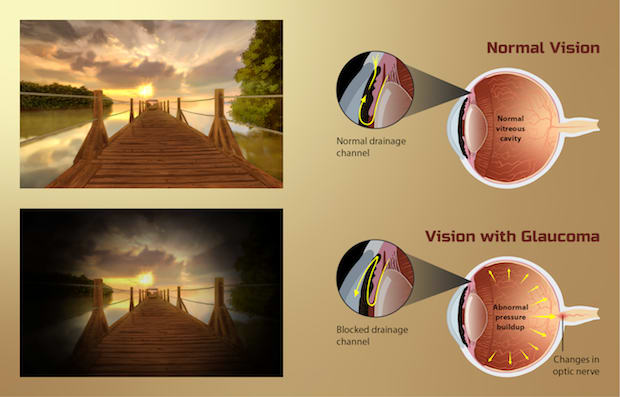Table of Contents
b. Treating Angle-Closure Glaucoma
Overview
Glaucoma is not a single condition, but a group of eye conditions. These conditions are linked together as they all affect and damage the eye’s optic nerve. Glaucoma is very common and is the second leading cause of blindness in the world. This condition affects around three million people in the United States. Since there are usually no early signs of the condition, many may be unaware that they have it. [1]
Glaucoma can affect one or both eyes. It is important that you have your eyes checked regularly and speak to a doctor at the earliest sign of vision changes. Vision loss from glaucoma is irreversible and may cause blindness if left untreated. [2]
Keep reading to learn more about the symptoms and treatment of glaucoma, including medications like Azopt (brinzolamide) and Alphagan P (brimonidine).

What Causes Glaucoma?
a. High Pressure in the Eye
Glaucoma occurs when the optic nerve becomes damaged. The optic nerve connects your eye to your brain, carrying impulses. These impulses are formed by the eye’s retina and then interpreted by the brain, allowing us to see. [3]
Usually, damage to the optic nerve is caused by an increased amount of pressure in the eye. The fluid inside your eye is known as aqueous humor. Typically, this flows out of your eye through a channel. However, high pressure can occur when there is a blockage in this channel. [4]
There can be several different reasons why this channel becomes blocked, including genetics, infections, inflammatory conditions, chemical injuries, or blunt injuries to the eye.
b. Risk Factors for Glaucoma
Glaucoma can affect anyone. However, some people may be more likely to develop the condition than others. Common risk factors for developing glaucoma include:
- Having a family history of glaucoma
- Having high pressure in the eye
- Having a thin cornea
- Being older than 60
- Having black, Asian, or Hispanic heritage
- Having medical conditions including diabetes, high blood pressure, heart disease, and sickle cell anemia
- Being severely nearsighted or farsighted
- Having previously had an eye injury or eye surgery
- Taking a corticosteroid medication, especially eye drops, for an extended period of time [2]
Types of Glaucoma
a. Open-Angle Glaucoma
When most people are talking about glaucoma, they are talking about open-angle glaucoma. Open-angle glaucoma (or chronic glaucoma) is by far the most common type of this condition. [5] This form usually has no symptoms other than the gradual loss of vision. This loss of vision may be so gradual, that you may not notice any changes until your peripheral vision is significantly impaired or encroaches into your central vision.

Open-angle glaucoma occurs when the drainage angle between the cornea (transparent front layer of the eye) and the iris (colored part of the eye) remains open. Over time, the drainage mechanism can become blocked, preventing fluid from draining out of the eye effectively.
b. Angle-Closure Glaucoma
Angle-closure glaucoma (or closed-angle glaucoma) occurs when the angle between your cornea and iris becomes blocked. This type of glaucoma can occur gradually (chronic) or suddenly (acute). Acute angle-closure glaucoma has several symptoms, including eye pain and redness, blurred vision, seeing halos around lights, severe headaches, nausea, and vomiting. [2]
c. Other Types of Glaucoma
Secondary glaucoma is another form of glaucoma that is typically caused by separate damage to the eye. This may be the result of an external injury to the eye or an eye condition like cataracts.
The cause of normal tension glaucoma is not known. This condition occurs when the optic nerve is damaged despite having normal eye pressure. [2]
Another type of glaucoma is congenital glaucoma. This form of the condition often runs in families and is a congenital defect in the angle of the eye. Common symptoms include excessive tearing, sensitivity to light, and cloudy eyes. [6]

How is Glaucoma Treated?
a. Eye Drops
Treating glaucoma often involves the use of prescription eye drops such as Azopt (brinzolamide) and Alphagan P (brimonidine). Eyedrops help decrease eye pressure by improving your eyes’ ability to drain fluid. There are several different types of eye drops that work to lower eye pressure in different ways. Your doctor may prescribe more than one type of eyedrop to treat your condition.
b. Treating Angle-Closure Glaucoma
Some forms of glaucoma, such as angle-closure glaucoma, can occur suddenly. If you are diagnosed with angle-closure glaucoma, you may need urgent treatment to reduce eye pressure. A common procedure for this is laser iridotomy, which involves creating an opening in the iris for fluid to drain. [2]
c. Other Treatment Options
In addition to prescription eye drops, there are other treatment options available to help reduce pressure in the eye. This includes laser therapy, inserting tubes to improve drainage, and forms of surgery like including filtering surgery and MIGS (minimally invasive glaucoma surgery).
The content in this article is intended for informational purposes only. This website does not provide medical advice. In all circumstances, you should always seek the advice of your physician and/or other qualified health professionals(s) for drug, medical condition, or treatment advice. The content provided on this website is not a substitute for professional medical advice, diagnosis, or treatment.
